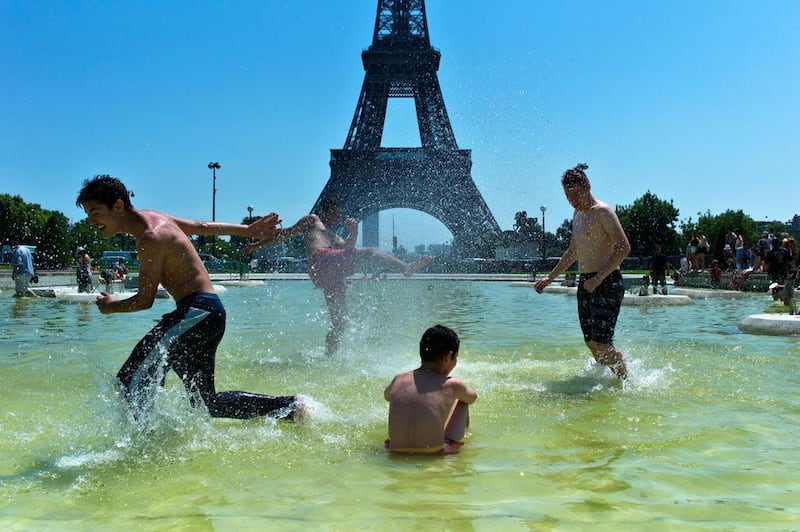It has been a summer of heatwaves, with records being set across the world, most recently in Iraq and Iran over the weekend. But while they might not top temperatures here in the UAE, some countries have struggled to cope.
Middle East
In the past few days, residents in the Iranian city of Bandar Mahshahr battled 46°C temperatures as an unprecedented heatwave enveloped the region. With the added humidity it felt like 73°C, according to AccuWeather.
To the west, temperatures also reached above 50°C last week in Iraq, with a recording of 52°C in Baghdad.
The heat prompted the Iraqi government to implement a mandatory four-day holiday and residents were urged to stay out of the sun and to drink plenty of water.
Unlike many countries in the Middle East, Iraq lacks beaches, and travel restrictions make it hard for people to escape from the heat.
Reports suggest that chronic electricity and water cuts in Iraq and other conflict-ridden countries make heatwaves even more unbearable, although those who can try to swim in rivers and canals, or spend time in air conditioned shopping malls.
India
In May, the world’s second most populous country was hit by a heatwave and temperatures reached 48°C degrees. Within a month, more than 2,500 people had died but the actual death toll was thought to be much higher.
Photographs circulated on social media and news websites of melting tarmac roads and men peddling air conditioning units from the back of bicycles. White painted road markings even disintegrated.
The government’s national disaster management authority (NDMA) says a temperature of 40°C degrees at a weather station in the Plains, or 30°C in a hilly region, qualifies as a heatwave. A severe heatwave is 47°C or more.
“India, too, is feeling the impact of climate change in terms of increased instances of heatwaves, which are more intense in nature with each passing year, and have a devastating impact on human health,” says the NDMA.
The government also blamed a poor monsoon.
Despite annual temperatures regularly hitting 40°C, the country is not well-equipped to cope, leaving the poor and elderly most at risk.
While more people install air conditioning in their homes, the pressure on the country’s power grid is great, causing power cuts during some of the hottest times. There are also water shortages.
Experts have written about “heat islands” in the country’s urban areas, where temperatures at night can be as much as 22°C higher than in surrounding areas. The buildings themselves absorb heat and there is a lack of vegetation to provide shade, transpiration and evaporation.
A 2013 study revealed that only 2 per cent of Indian households had air conditioning in 2007, but sales have increased by about 20 per cent year-on-year. This puts a huge strain on the power supply.
The sheer volumes of traffic in some areas – nine million registered vehicles in Delhi, for example – add to the problem in urban areas, with drivers stuck in poorly air conditioned cars with heat emitted from the vehicles themselves.
Taxi drivers in Calcutta steered clear of the city’s roads between 11am and 4pm on some of the hottest days after at least two drivers died of heatstroke.
In Andhra Pradesh, one of the country’s poorest regions, relatives of heatstroke victims were offered 100,000 rupees in compensation.
Pakistan
As temperatures in Pakistan rose to as high as 45°C, power cuts became more than just an annoyance.
At least 800 people died in June in the capital Karachi, most of them from heatstroke. Many blamed a lack of power and water.
The army was deployed to set up centres to cope with hundreds of people becoming ill, but political parties and politicians sidetracked, blaming each other for shortcomings in the way the country was coping.
There were protests in Karachi as people took to the streets to complain about the government and the main power company, who they blamed for the power cuts.
Mainland Europe
Weather alerts were triggered in France, Spain and Portugal after temperatures reached 40°C. France’s capital, Paris, launched its national heatwave plan, deploying lessons learned in a 2003 heatwave which killed up to 20,000 people.
Deaths across Europe that year were reported to be as high as 70,000.
In August 2003, the death toll was estimated to be 13,000 in France, in just one month.
As in many countries affected this summer, a lack of air conditioning exacerbated problems.
In France, public spaces with air conditioning were asked to allow the public to seek respite from the outside temperatures.
Some office workers in rooms without air conditioning tried to power down unused computers, switch off lights and move away from the windows in an effort to hide from the heat.
Replicating a practice already deployed in the UAE, farmers in Italy tried to keep milk production constant by keeping their cows cool.
Some rural farms introduced fans, air conditioning units and showers for cows, pigs and chickens.
United Kingdom
A heatwave swept the UK earlier this summer, to the delight of Britons who usually complain about the weather.
However, as temperatures topped 35°C, it also brought disruption. The national weather service, the Met Office, issued a heat health alert.
Hospitals and medical services made preparations for heat-related illnesses, while people with respiratory illnesses were warned to stay inside.
On July 1, temperatures hit 36.5°C, setting a UK record for the hottest day since 2003 and the warmest July day since records began.
The heatwave was caused by a warm front and tropical air band from Europe, but was soon followed by thunderstorms.
United States
California residents faced strict water restrictions this summer as a heatwave and lack of rainfall pushed the region into its fourth year of drought.
In June, they were instructed to cut their net total water use by a quarter.
In mid-July, up to 70 million US residents were put under a severe heat advisory as temperatures and humidity levels soared.
Korea
The hottest days of summer in Korea have their own name, Sambok, which refers to the start of the growing season.
Tradition dictates that cold baths are just for the weak and people should instead eat hot dishes such as chicken soup.
During this year’s festival, the North Korean government ordered state departments, schools and factories to open at 5am instead of 8am, on a special Sambok schedule.
Daily NK, a blog on North Korea based in Seoul, reported that the shift in working hours made little difference because of electricity shortages which disabled fans and air conditioners.
munderwood@thenational.ae





